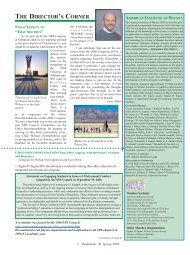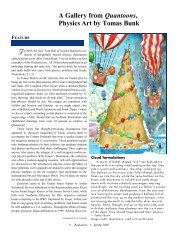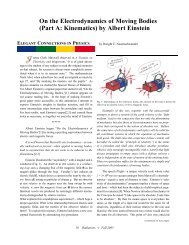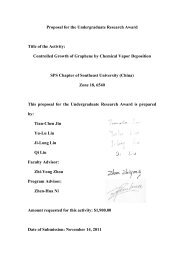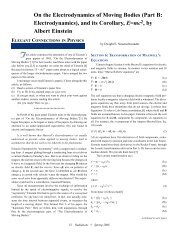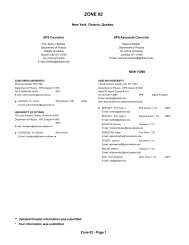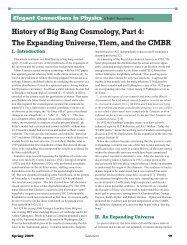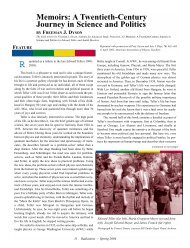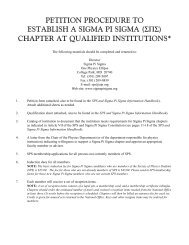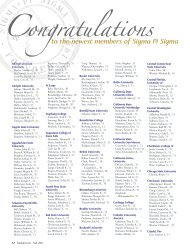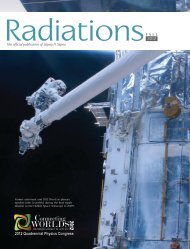NASA after the Shuttle: Begin in a Museum - Sigma Pi Sigma
NASA after the Shuttle: Begin in a Museum - Sigma Pi Sigma
NASA after the Shuttle: Begin in a Museum - Sigma Pi Sigma
You also want an ePaper? Increase the reach of your titles
YUMPU automatically turns print PDFs into web optimized ePapers that Google loves.
Elegant Connections <strong>in</strong> Physics<strong>NASA</strong> <strong>after</strong> <strong>the</strong> <strong>Shuttle</strong>:<strong>Beg<strong>in</strong></strong> <strong>in</strong> a <strong>Museum</strong>by Dwight E. NeuenschwanderIn 2011 <strong>the</strong> <strong>NASA</strong> Space <strong>Shuttle</strong> program came to its scheduledend when Atlantis rolled to a stop on <strong>the</strong> tarmac at <strong>the</strong> KennedySpace Center on July 21, conclud<strong>in</strong>g its last visit to <strong>the</strong> InternationalSpace Station. Now that <strong>the</strong> surviv<strong>in</strong>g shuttles are retir<strong>in</strong>gto museums, one may ask of <strong>NASA</strong>, “What comes next?” <strong>NASA</strong>has been <strong>in</strong> <strong>the</strong> “What next?” position before.Really now, what is <strong>NASA</strong> all about?To some a “space program” means jobsand contracts. To some a space programmeans national defense and “ma<strong>in</strong>ta<strong>in</strong><strong>in</strong>gsuperiority.” To some a space programmeans science and adventure andpush<strong>in</strong>g <strong>the</strong> envelope of what’s possibleby see<strong>in</strong>g what human be<strong>in</strong>gs can actuallyaccomplish. <strong>NASA</strong> has, of course,meant all those th<strong>in</strong>gs. As <strong>the</strong> shuttleorbiters beg<strong>in</strong> new careers as museumartifacts to preserve memories of what<strong>the</strong>y did, perhaps we should revisit o<strong>the</strong>rmuseum exhibits—and our memories—that tell <strong>the</strong> story of <strong>NASA</strong>’s legacy. Ifwe aspire to go beyond our predecessors,we would do well to remember and learnfrom <strong>the</strong>m. By review<strong>in</strong>g <strong>the</strong>ir motives,perhaps our own will be clarified. Byrevisit<strong>in</strong>g <strong>the</strong>ir setbacks and triumphs,our own <strong>in</strong>spiration may be revitalized.14 Radiations Fall 2011
From Columbiad to RedstoneLong before any artificial satellites wereplaced <strong>in</strong>to Earth orbit, <strong>the</strong> public’simag<strong>in</strong>ation was already primed forvisions of space travel to o<strong>the</strong>r worlds.Tales of such adventures as told <strong>in</strong> <strong>the</strong>mid-19th century <strong>in</strong>clude From <strong>the</strong> Earthto <strong>the</strong> Moon (1865) by Jules Verne, astory about a capsule called <strong>the</strong> Columbiad,bear<strong>in</strong>g three crew members thatlaunches to <strong>the</strong> moon by be<strong>in</strong>g firedfrom a cannon. In 1898 Konstant<strong>in</strong> Tsiolkovsky<strong>in</strong> Russia wrote The Investigationof Outer Space by Means of ReactionApparatus, which was published <strong>in</strong> 1903.In this nonfiction book Tsiolkovskycriticized <strong>the</strong> feasibility of Verne’s cannonlaunch scenario, calculat<strong>in</strong>g that <strong>the</strong>cannon barrel must be impossibly longand <strong>the</strong> shot would subject <strong>the</strong> crew tounsurvivable accelerations. However,An artist’s conception of how <strong>the</strong>Space <strong>Shuttle</strong> Enterprise will look<strong>in</strong> New York’s Intrepid <strong>Museum</strong>.<strong>NASA</strong> image.Tsiolkovsky credited Verne’s novel for<strong>in</strong>spir<strong>in</strong>g him to th<strong>in</strong>k seriously aboutspace flight. Also <strong>in</strong> 1898, H.G. Wellspublished The War of <strong>the</strong> Worlds <strong>in</strong>which <strong>the</strong> earth suffers <strong>in</strong>vasion bytechnologically advanced but ruthlessMartians. Receptivity to <strong>the</strong> novel’s<strong>the</strong>sis was aided by <strong>the</strong> mis<strong>in</strong>terpretation(about 1877) of Martian landscapefeatures as “canals,” giv<strong>in</strong>g traction to<strong>the</strong> notion that life might exist elsewhere<strong>in</strong> <strong>the</strong> solar system. Wells followedWar of <strong>the</strong> Worlds with First Men <strong>in</strong> <strong>the</strong>Moon (1901). Quality science fiction,by extrapolat<strong>in</strong>g slightly beyond knownlimitations, stretches <strong>the</strong> m<strong>in</strong>d towardnew possibilities that may lie just over<strong>the</strong> horizon. For adventures <strong>in</strong> space exploration,<strong>the</strong> 20th century began withimag<strong>in</strong>ation and anticipation.On December 17, 1903, Wilburand Orville Wright carried out <strong>the</strong> firstsuccessful airplane flight at Kitty Hawk,NC. Aircraft technology moved aheadso quickly that <strong>in</strong> 1915 <strong>the</strong> NationalAdvisory Committee for Aeronautics(NACA) was founded to coord<strong>in</strong>ate USfederally funded aviation research (<strong>the</strong>NACA would become <strong>NASA</strong> 43 yearslater). By 1914 Robert Goddard hadtaken out patents for liquid-fueled, solidfueled,and multistage rockets. His firstsuccessful liquid-fueled rocket flew onMarch 16, 1926, at Auburn, MA. Work<strong>in</strong>gmostly alone and despite limitedfunds, Goddard developed gyroscopes,fuel pumps, steer<strong>in</strong>g vanes, and parachutes.His experiments were noticedabroad, especially <strong>in</strong> Germany.In 1923 Hermann Oberth published<strong>in</strong> Germany <strong>the</strong> <strong>in</strong>fluential The Rocket<strong>in</strong>to Interplanetary Space, a quantitativestudy of solar system navigationdynamics us<strong>in</strong>g rocket eng<strong>in</strong>es andgravity.[1] Soon <strong>after</strong>ward, <strong>in</strong> Breslau,Germany (now Wroclaw, Poland), arocket enthusiast’s society, <strong>the</strong> Vere<strong>in</strong> fürRaumschiffahrt (VfR, German Societyfor Space Travel) was organized <strong>in</strong> arestaurant on June 5, 1927. The VfRpremise held that “out of small projects,large spacecraft can be developed which<strong>the</strong>mselves can be ultimately developedby <strong>the</strong>ir pilots and sent to <strong>the</strong> stars.” In1930 18-year-old Wernher von Braun,who had been profoundly <strong>in</strong>fluenced byElegant Connections <strong>in</strong> PhysicsOberth’s book, jo<strong>in</strong>ed <strong>the</strong> VfR. At anabandoned munitions dump near Berl<strong>in</strong>,VfR members soon had <strong>the</strong>ir rocketsstreak<strong>in</strong>g to altitudes of 2 km.In 1933 Adolf Hitler came to powerand VfR assets were seized. S<strong>in</strong>ce rocketswere not <strong>in</strong>cluded under <strong>the</strong> restrictionsof <strong>the</strong> Treaty of Versailles that endedWorld War I, German rocketry wasmade <strong>in</strong>to a bureaucracy with von Braunappo<strong>in</strong>ted its leader. With military sponsorshiphe led <strong>the</strong> development of <strong>the</strong>V-2 rocket at Peenemünde on <strong>the</strong> Balticcoast. Fueled with alcohol and liquidoxygen, <strong>the</strong> V-2 produced 56,000 lb ofthrust and could lift a 1-ton payload toa height of 100 miles. Nearly 4000 V-2swere fired dur<strong>in</strong>g World War II, but<strong>the</strong>y caused little damage <strong>in</strong> proportionto <strong>the</strong>ir cost. Near <strong>the</strong> war’s endvon Braun abandoned his headquartersat Peenemünde, retreated to <strong>the</strong> Bavarianmounta<strong>in</strong>s, stashed importantdocuments, and dispersed his team. Hesurrendered to <strong>the</strong> Americans and led<strong>the</strong>m to 14 tons of technical papers and100 disassembled V-2s. Then he and 125colleagues and <strong>the</strong>ir families migratedto El Paso, TX, as part of <strong>the</strong> US Army’sOperation Paperclip. At Fort Bliss <strong>the</strong>Army provided resources for <strong>the</strong> groupto resume design<strong>in</strong>g rockets, and <strong>the</strong>yorganized anew under von Braun’s leadershipas <strong>the</strong> US Army Ordnance MissileCommand. The V-2s were taken to <strong>the</strong>Army’s White Sands Prov<strong>in</strong>g Groundsnear Alamogordo, NM, and werelaunched <strong>the</strong>re from 1946 to 1952. AtWhite Sands <strong>the</strong> V-2 payload bays weremade available for research projects.A V-2 Upper Atmosphere Rocket andResearch Panel with representatives from<strong>the</strong> military, universities, and <strong>in</strong>dustryprovided access to a wide spectrum oftalent. With <strong>the</strong>se resources, advances <strong>in</strong>track<strong>in</strong>g, tim<strong>in</strong>g, telemetry, communications,safety, abort<strong>in</strong>g flights, <strong>in</strong>strumentation,and data recovery all movedquickly ahead. In April 1948 <strong>the</strong> panelchanged its name to <strong>the</strong> Rocket and SatelliteResearch Panel. In June 1950 vonBraun’s group relocated to Huntsville,AL, to occupy <strong>the</strong> vacated RedstoneArsenal facility and be near <strong>the</strong> AtlanticMissile Range at Cape Canaveral, FL,where <strong>the</strong> next generation of rocketsFall 2011 Radiations 15
Elegant Connections <strong>in</strong> Physicswould be launched. In Huntsville <strong>the</strong>yproduced V-2 successors, beg<strong>in</strong>n<strong>in</strong>g with<strong>the</strong> namesake Redstone rocket, produc<strong>in</strong>g78,000 lb of thrust, capable of carry<strong>in</strong>ga 3-ton payload on 200-mile ballisticflights. When <strong>the</strong> last V-2 was launched<strong>in</strong> 1952, an American space programwas tak<strong>in</strong>g root.Loom<strong>in</strong>g <strong>in</strong> <strong>the</strong> background of <strong>the</strong>sedevelopments were <strong>the</strong> new hydrogenbombs, which had first been tested onNovember 2, 1952. That first one, <strong>the</strong>USA’s “Mike” shot, used liquid hydrogenas fuel <strong>in</strong> a device far too large to be carriedanywhere. This round of Americansuperiority was short-lived, because <strong>the</strong>Soviets detonated <strong>the</strong>ir own hydrogenbomb on August 12, 1953. On March1, 1954, <strong>the</strong> compact lithium-deuteride“dry” design was successfully detonated<strong>in</strong> <strong>the</strong> Castle Bravo test on <strong>the</strong> MarshallIslands. By 1956 <strong>the</strong> Mark 17 hydrogenbomb was <strong>in</strong> production, which couldbe carried by <strong>the</strong> B-36 bomber. But arocket capable of plac<strong>in</strong>g a satellite <strong>in</strong>toorbit could deliver a nuclear weaponfrom Moscow to Wash<strong>in</strong>gton, DC, <strong>in</strong>about half an hour, beat<strong>in</strong>g <strong>the</strong> flighttime of any bomber. By <strong>the</strong> end of <strong>the</strong>1950s several fleets of large rocketswere available, <strong>in</strong>clud<strong>in</strong>g <strong>the</strong> Redstone,Vanguard, Thor, and Atlas vehicles. TheRedstone was created by von Braun for<strong>the</strong> Army, <strong>the</strong> Vanguard was a productof <strong>the</strong> Naval Research Laboratory, and<strong>the</strong> Thor and Atlas came from <strong>the</strong> AirForce.16 Radiations Fall 2011Invest<strong>in</strong>g <strong>in</strong> Imag<strong>in</strong>ationAcross <strong>the</strong> land were <strong>the</strong> taxpayers who,<strong>in</strong> a free society, would have to give atleast implicit consent to such publiclyfunded efforts. That required vision.Popular culture can be a good <strong>in</strong>dicatorof <strong>the</strong> state of public imag<strong>in</strong>ationand vision. With <strong>the</strong> com<strong>in</strong>g of c<strong>in</strong>emaand broadcast technologies, <strong>the</strong> classicscience fiction stories were quicklyadapted to movies, radio, and television,famously <strong>in</strong>clud<strong>in</strong>g <strong>the</strong> Orson Wellsradio broadcast on October 30, 1938, ofan adaption of War of <strong>the</strong> Worlds. Spacetravel and aliens <strong>in</strong>spired televisionprograms from <strong>the</strong> beg<strong>in</strong>n<strong>in</strong>g of <strong>the</strong> medium,as <strong>the</strong>y still do today. Some charactersand story l<strong>in</strong>es appeared earlier<strong>in</strong> pr<strong>in</strong>t, such as <strong>the</strong> Buck Rogers <strong>in</strong> <strong>the</strong>25th Century comic strip that began <strong>in</strong>1929, followed by Flash Gordon <strong>in</strong> 1934.Both were adapted to a series of televisionprograms: Buck Rogers aired fromApril 1950 to January 1951, and <strong>the</strong>Flash Gordon series ran from October1954 to April 1955. O<strong>the</strong>r space fictiontelevision programs from <strong>the</strong> early 1950s<strong>in</strong>cluded Space Patrol and Tom Corbett,Space Cadet. It is <strong>in</strong>terest<strong>in</strong>g that while<strong>the</strong>se shows were <strong>in</strong>tended for children,<strong>the</strong>y also attracted a follow<strong>in</strong>g amongadults. Perhaps <strong>the</strong> <strong>in</strong>nate childhoodcuriosity and fasc<strong>in</strong>ation with <strong>the</strong> world,so necessary for <strong>the</strong> spirit of science, wasreignited <strong>in</strong> <strong>the</strong> parents.Flash Gordon’s spaceship, <strong>the</strong> SkyFlash, resembled a stylized V-2 rocket.By today’s standards <strong>the</strong> visual effectsseem cheesy; for example, when <strong>the</strong>Sky Flash took off, little puffs of smokecame out <strong>the</strong> back of what was clearlya model suspended with f<strong>in</strong>e wires. Butkids my age watch<strong>in</strong>g at <strong>the</strong> time didnot care about such production trivia;we were used to play<strong>in</strong>g with toy modelsourselves, and our imag<strong>in</strong>ations did <strong>the</strong>rest. So we had a good time and cut <strong>the</strong>special effects technicians some slackthat would not be tolerated today, whencomputer-generated realistic images aretaken for granted.I don’t know what this says abouthuman nature, but <strong>the</strong> story l<strong>in</strong>es of<strong>the</strong>se programs were mostly aboutconflicts between Good Guy heroesand Bad Guy villa<strong>in</strong>s. Although FlashGordon and Tom Corbett used ray guns<strong>in</strong>stead of six-shooters, <strong>the</strong> story l<strong>in</strong>eswere similar to those of The Lone Rangeror Zorro; merely <strong>the</strong> sett<strong>in</strong>gs were different.However, for young viewers likeme, <strong>the</strong> sett<strong>in</strong>g was <strong>the</strong> po<strong>in</strong>t. Good orbad, <strong>the</strong> aliens from o<strong>the</strong>r worlds were<strong>in</strong>terest<strong>in</strong>g because <strong>the</strong>y were from o<strong>the</strong>rworlds. Such a conception would havebeen <strong>in</strong>conceivable to our counterparts<strong>in</strong>, say, <strong>the</strong> 14th century. Ah, this br<strong>in</strong>gsback a flood of memories . . .. . . It’s <strong>the</strong> mid-1950s. We can jo<strong>in</strong><strong>the</strong> Space Patrol Club and mail-order aSpace Patrol helmet with 25 cents anda cereal box top. . . . So <strong>the</strong>re we are,sport<strong>in</strong>g our Space Patrol helmets andbrandish<strong>in</strong>g our Buck Rogers Death Raypistols, sw<strong>in</strong>g<strong>in</strong>g our legs from chrome andv<strong>in</strong>yl kitchen chairs while watch<strong>in</strong>g <strong>the</strong>antics of space heroes and villa<strong>in</strong>s on littleblack-and-white television screens. But ourimag<strong>in</strong>ations soar off this planet and setout across <strong>the</strong> universe. . . .In <strong>the</strong> long view, perhaps Jules Verneand Flash Gordon had roles just asnecessary for <strong>the</strong> exploration of space <strong>in</strong><strong>the</strong> real world as were <strong>the</strong> roles of RobertGoddard, Wernher von Braun, and NeilArmstrong.Allow<strong>in</strong>g for <strong>the</strong> goals and limitationsof <strong>the</strong> medium, <strong>the</strong> Tom Corbett,Space Cadet show may have been <strong>the</strong>
Elegant Connections <strong>in</strong> Physicsmore scientifically realistic, as its producersolicited <strong>the</strong> services of scienceadvisors. Although to travel through<strong>the</strong> asteroid belt was to risk fall<strong>in</strong>g preyto space pirates who l<strong>in</strong>gered <strong>the</strong>re, <strong>the</strong>producers made Mars <strong>in</strong>to a desert andVenus <strong>in</strong>to a tropical jungle. They wereright about Mars, and because Venus isa cloud-wrapped planet about <strong>the</strong> size ofEarth and lies just with<strong>in</strong> <strong>the</strong> sun’s lifezone, one could still suppose <strong>in</strong> <strong>the</strong> early1950s that Venus might possibly be aglobal Costa Rica. Of course, <strong>the</strong> Sovietand American probes that flew by orlanded on Venus <strong>in</strong> <strong>the</strong> 1960s showed itssurface to be hot enough to melt lead. . . .. . . We were oh so disappo<strong>in</strong>ted—ourdreams of hack<strong>in</strong>g through a Venus jungleunderstory while watch<strong>in</strong>g out for giantscreech<strong>in</strong>g pterodactyls swoop<strong>in</strong>g down overour heads had to be set aside, replaced bya planet on which <strong>the</strong> greenhouse effectexperiment had already been done to <strong>the</strong>extreme! . . .Sputnik and ExplorerIt is said that one even<strong>in</strong>g <strong>in</strong> 1950, dur<strong>in</strong>ga ga<strong>the</strong>r<strong>in</strong>g <strong>in</strong> <strong>the</strong> home of JamesVan Allen, <strong>the</strong> conversation noted anupcom<strong>in</strong>g maximum <strong>in</strong> solar activity,turned to opportunities offered byrecent developments <strong>in</strong> computer androcket technologies, and recalled <strong>the</strong>International Polar Years of 1888 and1932. Thus was hatched <strong>the</strong> idea toorganize an International GeophysicalYear (IGY) to run from July 1957through December 1958. An <strong>in</strong>ternationalconsortium of scientific societiesagreed, and plann<strong>in</strong>g began. Americanparticipation was charged to a USNational Committee formed <strong>in</strong> March1953, which <strong>in</strong> turned organized panelsof technical experts to pursue projects<strong>in</strong> cosmic rays, auroras, geomagnetism,glaciology, gravity, ionosphere physics,meteorology, oceanography, seismology,solar activity, and rocketry. Both <strong>the</strong>US and Soviet governments aimed toplace satellites <strong>in</strong> orbit dur<strong>in</strong>g <strong>the</strong> IGY.The US government was represented byNACA participation on <strong>the</strong> US NationalCommittee. Official impetus for a USsatellite program accelerated <strong>in</strong> 1954with a jo<strong>in</strong>t Army-Navy proposal calledProject Orbiter. The follow<strong>in</strong>g year <strong>the</strong>Eisenhower adm<strong>in</strong>istration opted for<strong>the</strong> alternative Navy Project Vanguard<strong>in</strong>stead. In 1956 <strong>the</strong> Upper AtmosphereRocket and Satellite Research Panelorganized a symposium at <strong>the</strong> Universityof Michigan titled “The ScientificUses of Earth Satellites,” chaired by VanAllen. The US push was on for satellites<strong>in</strong> space.Then <strong>the</strong> world woke up on October4, 1957, to <strong>the</strong> news that <strong>the</strong> SovietUnion had done it first by successfullyplac<strong>in</strong>g <strong>the</strong> 184-lb Sputnik I <strong>in</strong>toEarth orbit. The iconic beep-beep-beepemitted by <strong>the</strong> sh<strong>in</strong>y sphere trail<strong>in</strong>g itsfour antenna wires became an <strong>in</strong>deliblememory to everyone who was aware ofit at <strong>the</strong> time. The Soviet achievementwas all <strong>the</strong> more remarkable given that<strong>the</strong> USSR had been laid waste dur<strong>in</strong>gWorld War II, which left its major cities<strong>in</strong> ru<strong>in</strong>s and some 25 million citizensdead. Despite so recent a calamity onso large a scale, Sputnik 1 demonstratedthat <strong>the</strong> technological prowess of <strong>the</strong>Soviet Union was not to be underestimated.Fur<strong>the</strong>rmore, Sputnik 2 quicklyfollowed, launched on November 3, amonth <strong>after</strong> its predecessor. Significantly,Sputnik 2 carried <strong>the</strong> world’s first passenger<strong>in</strong> orbit, a female terrier namedLaika. Throughout <strong>the</strong> rema<strong>in</strong>der of1957 <strong>the</strong> USSR could boast two satellites<strong>in</strong> orbit while <strong>the</strong> United States hadnone. The first US attempt to launch asatellite, on December 6, 1957, endedignom<strong>in</strong>iously when its Vanguard rocketsettled back onto <strong>the</strong> launch pad andexploded <strong>after</strong> reach<strong>in</strong>g a height of 4 ft.In <strong>the</strong> environment of <strong>the</strong> ColdWar, <strong>the</strong>se events set off alarm bells <strong>in</strong><strong>the</strong> establishments of US government,<strong>in</strong>dustry, and education. One could arguethat Sputnik was <strong>the</strong> best th<strong>in</strong>g thatcould have happened not only to <strong>the</strong> USspace program, but to technology andscience education as well. For example,on September 2, 1958, <strong>the</strong> National DefenseEducation Act, which emphasizedma<strong>the</strong>matics and science education, wassigned <strong>in</strong>to law.With <strong>the</strong> awareness that <strong>the</strong> SovietUnion could now exploit rocket technologyfor military use, <strong>in</strong> February 1958LEFTV-2 launch, September 29, 1949.Naval Research Laboratory photo.CENTERThe National Air and Space<strong>Museum</strong>’s replica of Sputnik 1.USAF photo.RIGHTA full-scale model of Explorer 1,held by (left to right) JPL’s DirectorWilliam <strong>Pi</strong>cker<strong>in</strong>g, James Van Allen,and Wernher von Braun, ca. January1958. JPL/<strong>NASA</strong> photo.Fall 2011 Radiations 17
Elegant Connections <strong>in</strong> Physics<strong>the</strong> Advanced Research Projects Agency(ARPA) was formed, with an office <strong>in</strong><strong>the</strong> Pentagon, to coord<strong>in</strong>ate US civilianand military efforts, make sure thatUS military technology would be moresophisticated than <strong>the</strong> technology of itspotential enemies, and formulate projects<strong>in</strong>tended to expand technology beyondimmediate military requirements.However, it must also be said that, <strong>in</strong>contrast to all <strong>the</strong> official suspicion, <strong>after</strong>Van Allen attended a cosmic ray meet<strong>in</strong>gwith Soviet scientists <strong>in</strong> 1959 he wrote,“At this conference, <strong>the</strong>re were manydiffer<strong>in</strong>g views and differ<strong>in</strong>g methods ofattack, but <strong>the</strong> problems were commonones to all of us and a unity of basicpurpose was everywhere evident.”There was more at stake swirl<strong>in</strong>garound Sputnik than scor<strong>in</strong>g <strong>the</strong> technicaladvantage du jour dur<strong>in</strong>g <strong>the</strong> ColdWar. National prestige was an asset tobe used as collateral for <strong>in</strong>fluence <strong>in</strong> <strong>the</strong>world marketplace of ideas. Politiciansand pundits spoke of <strong>the</strong> two Cold Waradversaries, who faced each o<strong>the</strong>r likeRobert Oppenheimer’s two scorpions<strong>in</strong> a bottle,[2] as “<strong>the</strong> West” with itsNorth Atlantic Treaty Organization,and <strong>the</strong> “Soviet Bloc” with its WarsawPact. These superpower actors playedto an audience consist<strong>in</strong>g of <strong>the</strong> rest of<strong>the</strong> world, especially <strong>the</strong> “unaligned”nations, <strong>the</strong>n called <strong>the</strong> “Third World.”Most Third World countries were formercolonies of <strong>the</strong> West, and with over50 million people hav<strong>in</strong>g just perished<strong>in</strong> a global war fought over pr<strong>in</strong>ciplesof self-determ<strong>in</strong>ation, <strong>the</strong> wheels ofcolonialism were beg<strong>in</strong>n<strong>in</strong>g to fall off. Inthis new paradigm many Third Worldnations were struggl<strong>in</strong>g to recover <strong>the</strong>irABOVEThe X-15 rocket plane. USAF photo.18 Radiations Fall 2011RIGHTWernher von Braun with models of <strong>the</strong>various Saturn rockets, Marshall SpaceFlight Center, May 1964, <strong>NASA</strong> photo.identities while try<strong>in</strong>g to build <strong>the</strong>irsocieties and economies. The West and<strong>the</strong> Soviet Bloc were locked <strong>in</strong> a strugglefor <strong>the</strong>ir allegiance—and access to <strong>the</strong>irresources would be nice, too. When <strong>the</strong>leader of <strong>the</strong> Cuban revolution, FidelCastro, aligned himself with <strong>the</strong> Soviets<strong>in</strong> January 1959, <strong>the</strong> po<strong>in</strong>t was sharplyemphasized.[3] As a consequence of policiesguided by a “dom<strong>in</strong>o” hypo<strong>the</strong>sis,that year also saw <strong>the</strong> first US casualties<strong>in</strong> <strong>the</strong> former French colony of Vietnam.For <strong>the</strong> sake of <strong>in</strong>ternational public relations,<strong>the</strong> USA had to get a satellite <strong>in</strong>toorbit, and do it fast.Immediately <strong>after</strong> Sputnik <strong>the</strong> Army-Navy Project Orbiter program was revivedand given new life as <strong>the</strong> Explorerprogram. The Army Ballistic MissileAgency, toge<strong>the</strong>r with <strong>the</strong> Jet PropulsionLaboratory, assembled <strong>in</strong> 84 days <strong>the</strong>Explorer 1 satellite and launch vehicle,<strong>the</strong> latter a Redstone modified under<strong>the</strong> supervision of von Braun. Explorer 1was successfully launched <strong>in</strong>to orbit onJanuary 31, 1958. It weighed 31 poundsand was launched by a rocket weigh<strong>in</strong>g32 tons.Foreshadow<strong>in</strong>g <strong>the</strong> research capabilitiesof satellites and space probesto come, <strong>the</strong> Explorer satellites carried<strong>in</strong>struments for study<strong>in</strong>g cosmic rays.They bore <strong>the</strong> f<strong>in</strong>gerpr<strong>in</strong>ts of James VanAllen, who started study<strong>in</strong>g cosmic raysas an undergraduate. Dur<strong>in</strong>g WWIIhe helped develop <strong>the</strong> proximity fuzeat <strong>the</strong> Johns Hopk<strong>in</strong>s Applied PhysicsResearch Lab [4] and <strong>in</strong> 1951 becamechair of <strong>the</strong> physics department at <strong>the</strong>University of Iowa. Van Allen and hisstudents developed rockets that werefired from high-altitude balloons, acomb<strong>in</strong>ation called a “rockoon.” Rockoonslaunched from Newfoundland <strong>in</strong>1953 found <strong>the</strong> first h<strong>in</strong>ts of <strong>the</strong> highaltitudebelts of charged particles thatwould later bear Van Allen’s name. Todetect micrometeorites and cosmic rays,<strong>the</strong> slender cyl<strong>in</strong>drical Explorer satellitecarried counters and electronics built byVan Allen’s group. Explorer 1 detecteda cosmic ray count much lower thanexpected. Van Allen hypo<strong>the</strong>sized that<strong>the</strong> detectors were saturated because <strong>the</strong>satellite passed through a belt of chargedparticles trapped by <strong>the</strong> earth’s magneticfield. These belts, now called <strong>the</strong> VanAllen Belts, were confirmed by Explorer3 <strong>in</strong> March 1958.From Aeronautics to SpaceIn <strong>the</strong> 1950s <strong>the</strong> dist<strong>in</strong>ction betweenairplanes and spacecraft was becom<strong>in</strong>gblurred. One of NACA’s more dramaticsuccesses, completed <strong>in</strong> cooperation with<strong>the</strong> Army Air Corps, was <strong>the</strong> developmentof <strong>the</strong> X-1 rocket plane, <strong>the</strong> firstaircraft to “break <strong>the</strong> sound barrier.”After much test<strong>in</strong>g this barrier was brokenon October 14, 1947, when ChuckYeager and Glamorous Glennis reachedMach 1.06. The X-1 led to proposalsby 1954 for rocket eng<strong>in</strong>e and airframedesigns that became <strong>the</strong> X-15, on whichconstruction began <strong>in</strong> 1956.The X-15 rocket plane bridged <strong>the</strong>transition from airplanes to spacecraft.The X-15 program conducted flight testsfrom June 1959 to October 1967. Therocket plane was released from a B-52at an altitude of 8 miles and its rocketwould ignite, shoot<strong>in</strong>g it to altitudesknock<strong>in</strong>g on <strong>the</strong> door of suborbitalflight. After rocket<strong>in</strong>g to above essentiallyall <strong>the</strong> atmosphere, <strong>the</strong> X-15 glidedto a land<strong>in</strong>g on <strong>the</strong> earth. Several of itspilots were recognized with astronautw<strong>in</strong>gs on <strong>the</strong>ir uniforms, a dist<strong>in</strong>ctionearned only by those who reachedaltitudes greater than 100 km. Among<strong>the</strong>se were <strong>the</strong> future Apollo 11 commanderNeil Armstrong and a future
Elegant Connections <strong>in</strong> PhysicsSpace <strong>Shuttle</strong> pilot Joe Engle. The X-15still holds <strong>the</strong> official speed recordfor a rocket-powered aircraft (Mach6.72, set by Joe Knight on October 3,1967), and on October 22, 1963, it setan altitude record for rocket-poweredaircraft (107.96 km by Joe Walker) thatstood until October 4, 2007, whenSpaceShipOne piloted by Mike Melvillreached 111.996 km.. . . There was a sixth-grade textbook(now lost), a collection of assorted read<strong>in</strong>gsthat <strong>in</strong>cluded an essay by an X-15pilot. . . . With<strong>in</strong> its pages I see myselfstrapped <strong>in</strong>to <strong>the</strong> X-15 cockpit, black skyabove, blue Earth curv<strong>in</strong>g away 70 milesbelow, pressed back <strong>in</strong>to <strong>the</strong> seat by <strong>the</strong>rocket’s blaz<strong>in</strong>g acceleration, go<strong>in</strong>g fasterand faster. . . . The author expla<strong>in</strong>ed whyI do not hear <strong>the</strong> rocket’s radiated roaras I outrace <strong>the</strong> sound waves; all I hearfrom <strong>the</strong> X-15 itself are <strong>the</strong> sounds from<strong>the</strong> mach<strong>in</strong>e’s operation, transmitted tome through <strong>the</strong> airframe. . . . Back on<strong>the</strong> ground, look<strong>in</strong>g <strong>in</strong>to a clear blue sky Iimag<strong>in</strong>e <strong>the</strong> X-15 up <strong>the</strong>re out of sight. . . .To this day, whenever I f<strong>in</strong>d myself <strong>in</strong> <strong>the</strong>National Air and Space <strong>Museum</strong>, amid<strong>the</strong> many jaw-dropp<strong>in</strong>g storied aircraftand spacecraft resid<strong>in</strong>g <strong>the</strong>re, I have tovisit one that seems a personal friend,X-15-1, serial number 56-6670. It was <strong>the</strong>first of <strong>the</strong> three X-15s built, and wheneverI see it that sixth-grade kid lives aga<strong>in</strong> <strong>in</strong>my m<strong>in</strong>d, outrac<strong>in</strong>g sound on <strong>the</strong> edge ofspace, look<strong>in</strong>g for a ride to <strong>the</strong> moon. . . .By <strong>the</strong> time <strong>the</strong> X-15 came along, <strong>the</strong>role of “aeronautics” <strong>in</strong> national policyclearly needed to <strong>in</strong>clude “space” asLEFTHam <strong>after</strong> his Mercury flight, aboard <strong>the</strong>recovery ship USS Donner and shak<strong>in</strong>ghands with <strong>the</strong> ship’s commander,January 31, 1961. <strong>NASA</strong> photo.well. Thus was <strong>the</strong> National Aeronauticsand Space Adm<strong>in</strong>istration formedon October 1, 1958, as <strong>the</strong> successor toNACA. <strong>NASA</strong> <strong>in</strong>herited a deep benchwith which to field a space program,<strong>in</strong>clud<strong>in</strong>g <strong>the</strong> fleet of available rocketsand <strong>the</strong> oncom<strong>in</strong>g X-15, <strong>in</strong> addition tomore exotic proposals regard<strong>in</strong>g nuclearpropulsion that required long-termdecisions to be made.[5] The programto develop what became <strong>the</strong> largestboosters of all was <strong>in</strong>itiated by ARPA <strong>in</strong><strong>the</strong> summer of 1958 under <strong>the</strong> auspicesof <strong>the</strong> Department of Defense. The outcomewas <strong>the</strong> Saturn family of rockets,which culm<strong>in</strong>ated with <strong>the</strong> mighty SaturnV, <strong>the</strong> largest of von Braun’s designs.The Saturn V first stage consumed28,000 lb of liquid oxygen and keroseneper second and produced 7.5 million lbof thrust. Management of <strong>the</strong> Saturnprogram shifted to <strong>NASA</strong> <strong>in</strong> 1959. OnJuly 1, 1960, von Braun’s operation <strong>in</strong>Huntsville was officially transferred to<strong>NASA</strong> and became <strong>the</strong> George C. MarshallSpace Flight Center.As <strong>the</strong> new agency prepared forlaunches carry<strong>in</strong>g astronauts, a fleet ofsatellites was launched with missions toplanet Earth. <strong>NASA</strong>’s first meteorologicalsatellite, Trios 1, lifted off its launchpad on April 1, 1960. Communicationsatellites went aloft about <strong>the</strong> same time,beg<strong>in</strong>n<strong>in</strong>g with Echo 1 <strong>the</strong> follow<strong>in</strong>g August12. These giant metallic balloons(100 ft diameter) were <strong>in</strong>flated <strong>in</strong> orbit,where radio signals were reflected off<strong>the</strong>m. . . .In that dawn of humanity’s tentativesteps <strong>in</strong>to space, I am a second graderplay<strong>in</strong>g outside <strong>after</strong> dark and see a brightgleam<strong>in</strong>g “star” mov<strong>in</strong>g fast from horizonto horizon. In response to my shouts of“Come look, a satellite!” everyone dashesout of <strong>the</strong> house to gaze at this awesomesight. We realize that, <strong>in</strong> <strong>the</strong> long history of<strong>the</strong> world, no one has ever seen this wonderbefore, and we are grateful to be present aswitnesses. . . . Those were stirr<strong>in</strong>g times,and rema<strong>in</strong> vivid memories. To this day,every time I see a satellite sweep<strong>in</strong>g across<strong>the</strong> sky I recall <strong>the</strong> excitement of <strong>the</strong> earlypost-Sputnik era. Although now we caneasily track satellites on a website’s smallscreen,[6] see<strong>in</strong>g <strong>the</strong> real th<strong>in</strong>g streak across<strong>the</strong> wide sky with my own eyes still offers adeeply satisfy<strong>in</strong>g moment.America’s first astronaut was anaffable chimpanzee named Ham, whoflew <strong>in</strong> a Mercury capsule launched bya Redstone rocket on January 31, 1961.Ham had been tra<strong>in</strong>ed to pull levers <strong>in</strong>response to sounds and flash<strong>in</strong>g lightsto gauge whe<strong>the</strong>r one could ma<strong>in</strong>ta<strong>in</strong>mental alertness <strong>in</strong> space flight. Hamperformed his tasks well, but he hadquite a ride. The rocket’s angle of ascentwas one degree too steep, <strong>the</strong> flight hadto be aborted, and Ham flew higher (155mi), faster (5000 mph), and experiencedgreater acceleration than planned.Fur<strong>the</strong>rmore, when <strong>the</strong> capsule overshotits <strong>in</strong>tended Atlantic Ocean land<strong>in</strong>g siteby 130 miles, it began to s<strong>in</strong>k. But arescue crew reached Ham <strong>in</strong> time, andhe emerged from <strong>the</strong> capsule <strong>in</strong> goodhumor, accept<strong>in</strong>g his bonus of an appleand an orange. Although Ham’s flightended happily,[7] <strong>NASA</strong> saw that it hadsome glitches to fix before send<strong>in</strong>g moreastronauts aloft, but Ham’s adventureclearly demonstrated that human spaceflight was with<strong>in</strong> reach.The Challenge to Imag<strong>in</strong>e BigOn April 12, 1961, <strong>the</strong> Soviet spaceprogram scored ano<strong>the</strong>r touchdownwhen cosmonaut Yuri Gagar<strong>in</strong> became<strong>the</strong> first human be<strong>in</strong>g to go <strong>in</strong>to “outerspace.” His Vostok spacecraft made a106-m<strong>in</strong>ute orbit around <strong>the</strong> earth. Thisdisplay of Soviet competence stood <strong>in</strong>stark contrast to ano<strong>the</strong>r event on <strong>the</strong>ground that played out that same week,when an <strong>in</strong>vasion of Cuba, carried outby CIA-tra<strong>in</strong>ed Cuban exiles with <strong>the</strong><strong>in</strong>tention of overthrow<strong>in</strong>g <strong>the</strong> Castroregime, ended <strong>in</strong> disaster at <strong>the</strong> Bay of<strong>Pi</strong>gs. April 1961 was not a good monthfor <strong>the</strong> new Kennedy adm<strong>in</strong>istration.However, US fortunes improved<strong>the</strong> next month, when on May 5 AlanShepard became America’s first hu-Fall 2011 Radiations 19
Elegant Connections <strong>in</strong> PhysicsApollo 8 astronauts hold what may be <strong>the</strong>most unusual press conference of all time.As <strong>the</strong>y orbit <strong>the</strong> moon 70 miles above itscratered surface, <strong>the</strong>y read aloud verses1–10 from <strong>the</strong> first chapter of <strong>the</strong> Book ofGenesis, K<strong>in</strong>g James Version. As we <strong>in</strong> ourliv<strong>in</strong>g rooms hear <strong>the</strong> astronauts read <strong>the</strong>ancient text <strong>in</strong> Elizabethan English, ourtelevision screens show <strong>the</strong> face of <strong>the</strong> fullmoon through a telescope, and we know<strong>the</strong> astronauts are <strong>in</strong> our field of view. . . .Into that moment is compressed severalthousand years of human yearn<strong>in</strong>g foradventure and mean<strong>in</strong>g. . . .The follow<strong>in</strong>g summer, on June 16,1969, began <strong>the</strong> climax of <strong>the</strong> decadewith <strong>the</strong> launch of Apollo 11. Threedays later, as Michael Coll<strong>in</strong>s orbited <strong>the</strong>moon <strong>in</strong> <strong>the</strong> command module Columbia,Neil Armstrong and Buzz Aldr<strong>in</strong>drove <strong>the</strong> Eagle LM to <strong>the</strong> lunar surface.They landed with 25 seconds of fuelrema<strong>in</strong><strong>in</strong>g <strong>in</strong> <strong>the</strong> LM’s descent stage,and we heard “Tranquility Base here,<strong>the</strong> Eagle has landed.” Anyone who sawTOP LEFTEarth as seen <strong>in</strong> a live television broadcastfrom Apollo 8, altitude 176,533 miles,December 23, 1968. <strong>NASA</strong> photo.BOTTOM LEFTEarthrise from lunar orbit, Apollo 8,December 24, 1968. <strong>NASA</strong> photo.TOP RIGHTLaunch of Apollo 11, July 16, 1969. <strong>NASA</strong> photo.MIDDLE RIGHTNeil Armstrong descend<strong>in</strong>g <strong>the</strong> lunar moduleladder, as seen by television viewers onEarth, July 20, 1969. <strong>NASA</strong> photo.BOTTOM RIGHTBuzz Aldr<strong>in</strong> on <strong>the</strong> moon, December 20, 1969.Photo by Neil Armstrong. <strong>NASA</strong> photo.22 Radiations Fall 2011
Elegant Connections <strong>in</strong> Physicsit will never forget. . . .We watched <strong>the</strong> clock throughout thatSunday, determ<strong>in</strong>ed to be <strong>in</strong> front of atelevision set at <strong>the</strong> time announced for <strong>the</strong>astronauts to emerge from <strong>the</strong> LM. That<strong>after</strong>noon, watch<strong>in</strong>g <strong>in</strong> <strong>the</strong> basement ofmy house with friends, and by extension,watch<strong>in</strong>g with a fifth of <strong>the</strong> world’s population,we beheld <strong>the</strong> ghostly black-andwhiteimage of Neil Armstrong descend<strong>in</strong>g<strong>the</strong> ladder <strong>in</strong> <strong>the</strong> shadow of <strong>the</strong> LM. Hepaused on <strong>the</strong> spacecraft’s pod and said“I’m go<strong>in</strong>g to step off <strong>the</strong> LM now. . . .”As Neil Armstrong took <strong>the</strong> step thatno one had ever taken before, his wordswere elegant <strong>in</strong> <strong>the</strong>ir simplicity: “That’sone small step for a man, one giant leapfor mank<strong>in</strong>d.” Eight years had elapseds<strong>in</strong>ce President Kennedy’s challenge. Ittook over 20 billion 1960s dollars spreadover that decade, and, as Armstrongrem<strong>in</strong>ded everyone later, a “third of amillion people” to “manage it.”[11] But<strong>the</strong> accomplishments <strong>in</strong> space dur<strong>in</strong>gthose years will be remembered long <strong>after</strong><strong>the</strong>ir costs and <strong>the</strong> Cold War motivesthat accelerated <strong>the</strong>m have been buriedand forgotten.Twenty-four Apollo astronautsorbited <strong>the</strong> moon, and twelve walkedon its surface. So far <strong>the</strong>y are <strong>the</strong> onlyhuman be<strong>in</strong>gs to leave low-Earth orbitand see with <strong>the</strong>ir own eyes <strong>the</strong> moon upclose and Earth from afar. The ten astronautswho walked on <strong>the</strong> moon <strong>after</strong>Apollo 11 stayed longer and went far<strong>the</strong>rand collected more data than Armstrongand Aldr<strong>in</strong>, but even dur<strong>in</strong>g <strong>the</strong> flightof Apollo 12, many people from <strong>the</strong>country who sent <strong>the</strong>m did not evenbo<strong>the</strong>r to look up. We had been <strong>the</strong>re,done that. Apollo 13 captured much<strong>in</strong>terest because it came so close to end<strong>in</strong>g<strong>in</strong> tragedy. The rema<strong>in</strong><strong>in</strong>g Apolloflights were enormously successful.The last moon mission was Apollo 17<strong>in</strong> December 1972. By <strong>the</strong>n <strong>the</strong> Nixonadm<strong>in</strong>istration had decided to cancelApollos 18, 19, and 20 to save money,given <strong>the</strong> dim<strong>in</strong>ished public <strong>in</strong>terest.I suppose it is a property of humannature that <strong>the</strong> amaz<strong>in</strong>g, when repeated,becomes ord<strong>in</strong>ary. Gus Grissom, beforehis Mercury flight of July 21, 1961, said<strong>after</strong> Alan Shepard’s flight, “There won’tbe this much fuss <strong>the</strong> next time. Onceyou’ve seen one, you’ve seen ‘em all.”[12]The moon land<strong>in</strong>gs presented <strong>NASA</strong>with a hard act to follow. One wonderedwhat <strong>NASA</strong> would do next. Us<strong>in</strong>gleftover Apollo hardware, we soon hadSkylab (1973–1979), where a SaturnIVB stage was modified <strong>in</strong>to an orbit<strong>in</strong>glaboratory. Then came Apollo-Soyuz(July 1975), an encourag<strong>in</strong>g gesture ofUS/USSR cooperation that offered somek<strong>in</strong>d of benediction to <strong>the</strong> Cold WarSpace Race, while show<strong>in</strong>g what mighthave been, and can be, for <strong>in</strong>ternationalcooperation. Meanwhile, of course,<strong>NASA</strong> eng<strong>in</strong>eers and managers had beenlook<strong>in</strong>g ahead.The cost of expendable boosters andmodules makes unsusta<strong>in</strong>able <strong>the</strong> practiceof depend<strong>in</strong>g on <strong>the</strong>m for rout<strong>in</strong>eaccess to space. For commut<strong>in</strong>g to work<strong>in</strong> orbit, a reusable vehicle would be essential.Toward that end, <strong>the</strong> next longtermprogram was <strong>the</strong> Space <strong>Shuttle</strong>.The Space <strong>Shuttle</strong>The shuttle program started <strong>in</strong> <strong>the</strong> late1960s. Overshadowed by <strong>the</strong> anticipatedlunar land<strong>in</strong>gs, it received little attentionuntil <strong>the</strong> mid-1970s. As <strong>the</strong> Apollomissions became rout<strong>in</strong>ely successfuland <strong>the</strong> public’s enthusiasm cooled forwatch<strong>in</strong>g astronauts pick up rocks, by<strong>the</strong> early 1970s <strong>the</strong> public’s gaze shiftedto concerns closer to home. With anunpopular war dragg<strong>in</strong>g on <strong>in</strong> Vietnam,amid <strong>the</strong> push for civil rights andconcerns about poverty, pollution, anda loom<strong>in</strong>g energy crisis, <strong>the</strong> Americanpublic began ask<strong>in</strong>g what <strong>the</strong>y weregett<strong>in</strong>g for <strong>the</strong>ir money with yet ano<strong>the</strong>rvisit to <strong>the</strong> moon. Even though <strong>NASA</strong>’sbudget was a small fraction of <strong>the</strong>federal budget, should <strong>the</strong> expenditureof <strong>NASA</strong>’s billions be directed to solv<strong>in</strong>gproblems here on Earth? Unlike <strong>the</strong>Mercury, Gem<strong>in</strong>i, and Apollo spacecraft,each shuttle could be reused,which looked like a better sale to a skepticalpublic. The construction of <strong>the</strong> firstorbiter, <strong>the</strong> Columbia, began <strong>in</strong> 1974.In September 1976 <strong>the</strong> public got a firstlook at it. The Columbia and all o<strong>the</strong>rshuttles had <strong>the</strong>ir orig<strong>in</strong>s <strong>in</strong> <strong>the</strong> X-1,X-15, and X-20 rocket planes that weredeveloped from <strong>the</strong> late 1940s through<strong>the</strong> 1960s.Before <strong>the</strong> X-15 made its first flight<strong>in</strong> 1959, <strong>the</strong> X-20 spaceplane was already<strong>in</strong> <strong>the</strong> works. Also called <strong>the</strong> Dyna-Soarfor “dynamic soar<strong>in</strong>g,” <strong>the</strong> X-20 was<strong>the</strong> focus of an Air Force program todevelop a piloted delta-w<strong>in</strong>g spaceplanethat could travel as high and as fast asan <strong>in</strong>tercont<strong>in</strong>ental ballistic missile,go<strong>in</strong>g <strong>in</strong>to suborbital flight if necessary,extend<strong>in</strong>g its range by skipp<strong>in</strong>g off <strong>the</strong>upper atmosphere. It would return toa land<strong>in</strong>g strip <strong>in</strong> an unpowered glide.Due to its high cost and questionableusefulness, <strong>the</strong> X-20 program wascanceled <strong>in</strong> December 1963 before a firstprototype was built. However, <strong>in</strong> <strong>the</strong>early 1970s <strong>NASA</strong> gave <strong>the</strong> X-20 draw<strong>in</strong>gsnew life as <strong>the</strong> Space <strong>Shuttle</strong>. Bothcraft were delta-w<strong>in</strong>ged vehicles boosted<strong>in</strong>to orbit by large rockets, would glideback to Earth and land on a runway likean airplane, and do it all over aga<strong>in</strong>.The shuttle program was formally<strong>in</strong>itiated on January 5, 1972, with anannouncement from President Nixon.<strong>NASA</strong> orig<strong>in</strong>ally envisioned a launchschedule that would approach onelaunch per week. Compromises wereeventually made from a fully reusabledesign to one that featured reusableorbiters and solid rocket boosters but anexpendable liquid fuel tank. Columbia’sfirst flight occurred on April 12, 1981,<strong>the</strong> 20th anniversary of Yuri Gagar<strong>in</strong>’sfirst orbital flight.The shuttle’s utility <strong>in</strong> putt<strong>in</strong>gsatellites and probes <strong>in</strong>to orbit, suchas <strong>the</strong> Galileo mission to Jupiter and<strong>the</strong> Hubble Space Telescope, are mattersof record and pride. <strong>Shuttle</strong>s flew 135missions. The tragedies on two of <strong>the</strong>m,with <strong>the</strong> losses of <strong>the</strong> crews aboard Challengerand Columbia, sadly rem<strong>in</strong>dedus yet aga<strong>in</strong> of how <strong>the</strong> high velocities,extreme temperatures and pressures, and<strong>the</strong> firepower on which one sits make<strong>the</strong> exploration of space so dangerous anadventure.The shuttles made possible <strong>the</strong>American contribution to <strong>the</strong> constructionof <strong>the</strong> International Space StationFall 2011 Radiations 23
Elegant Connections <strong>in</strong> PhysicsABOVEArtist render<strong>in</strong>g of <strong>the</strong> X-20 approach<strong>in</strong>g aland<strong>in</strong>g at Edwards Air Force Base. Djorampublic doma<strong>in</strong> image.TOP RIGHTSpace <strong>Shuttle</strong> launch. <strong>NASA</strong> photo.BOTTOM RIGHTStage 1 of <strong>the</strong> Apollo 18 Saturn V booster,with author and students, Johnson SpaceCenter, Houston Texas, November 7, 1992.Author photo.(ISS), <strong>the</strong> largest manmade structureplaced <strong>in</strong> orbit to date.It is early nighttime <strong>in</strong> central Oklahoma,and <strong>the</strong> ISS and shuttle are to bevisible toge<strong>the</strong>r from here at about 8 pm.Here <strong>the</strong>y come!—like two Venuses rac<strong>in</strong>gacross <strong>the</strong> sky, sweep<strong>in</strong>g so swiftly fromsouthwest to nor<strong>the</strong>ast. From <strong>the</strong> anglesubtended between <strong>the</strong>m, and assum<strong>in</strong>g atypical orbit altitude, I estimate <strong>the</strong> shuttleto be trail<strong>in</strong>g <strong>the</strong> ISS by some 600 miles; aday’s drive for us, but which <strong>the</strong>y cover <strong>in</strong>seconds. . . .With <strong>the</strong> ISS construction nowf<strong>in</strong>ished, <strong>the</strong> Space <strong>Shuttle</strong> program hasserved its purpose. The last shuttle tofly was Atlantis, launched July 8, 2011.Upon its return on July 21, all <strong>the</strong> surviv<strong>in</strong>gshuttles—Atlantis, Discovery, andEndeavor, along with <strong>the</strong> Enterprise thatwas used <strong>in</strong> early glid<strong>in</strong>g tests—are nowmak<strong>in</strong>g <strong>the</strong>ir ways to places of honoredretirement <strong>in</strong> dist<strong>in</strong>guished museums.What’s Next?As we asked follow<strong>in</strong>g Apollo, now wemay ask, <strong>after</strong> STS-135, “What’s next?”Dur<strong>in</strong>g a 1989 CBS television documentarythat celebrated <strong>the</strong> 20th anniversaryof Apollo 11, <strong>in</strong> a clos<strong>in</strong>g commentaryDan Ra<strong>the</strong>r recalled how <strong>in</strong> <strong>the</strong> 1960s<strong>the</strong> American people took a great riskand had a great adventure. Today, hesaid, <strong>the</strong>re is less adventure.[13] Sharedadventure can pull a society toge<strong>the</strong>rfor a time, and manned missions lookgreat on television. Missions with hu-24 Radiations Fall 2011
Elegant Connections <strong>in</strong> Physicsman crews are sometimes necessary, asdemonstrated <strong>in</strong> shuttle flights to service<strong>the</strong> Hubble Space Telescope. But perhapswe glean more science per dollar withrobotic probes. Soon <strong>after</strong> <strong>the</strong> flightsof Sputnik and Explorer and through<strong>the</strong> present moment, such probes havefanned out across <strong>the</strong> solar system.Among <strong>the</strong> pan<strong>the</strong>on of mach<strong>in</strong>es thathave carried <strong>the</strong> work of our hands too<strong>the</strong>r worlds and returned to us knowledge,we recite a dist<strong>in</strong>guished sampl<strong>in</strong>g:Ranger 7, lunar probe (1964);<strong>the</strong> Soviet Venera 3 Venus lander (1965);Mar<strong>in</strong>er 9 Mars orbiter (1971);<strong>the</strong> Soviet Mars 3 lander (1971);Mar<strong>in</strong>er 10 flyby of Venus and Mercury(1973);<strong>Pi</strong>oneer 10, <strong>the</strong> first probe to negotiate<strong>the</strong> asteroid belt and <strong>the</strong>n fly by Jupiter(1973, last contact 2003);<strong>Pi</strong>oneer 11 flybys of Jupiter and Saturn<strong>in</strong> 1973 (last contact 1995);Voyager 1, launched <strong>in</strong> 1977, flyby ofJupiter (1979) and Saturn (1980), stilltransmitt<strong>in</strong>g data back to Earth, nownear <strong>the</strong> heliosphere and head<strong>in</strong>g out of<strong>the</strong> solar system;Voyager 2, zoomed past Jupiter (1979),Saturn (1980), Uranus (1986), and Neptune(1989), still transmitt<strong>in</strong>g, and alsohead<strong>in</strong>g out of <strong>the</strong> solar system;<strong>the</strong> European Space Agency’s Giotto thatflew by Halley’s Comet (1986);Galileo, launched 1989, flybys of Venus,Earth, asteroids, orbited Jupiter (1995);Magellan orbiter that radar-mapped <strong>the</strong>surface of Venus (1989);Mars Pathf<strong>in</strong>der and its rover Sojourner(1997);<strong>the</strong> Mars rovers Spirit and Opportunity(active 2004–2010);NEAR Shoemaker, that orbited andtouched down on an asteroid (2001);Cass<strong>in</strong>i, launched <strong>in</strong> 1994, began orbit<strong>in</strong>gSaturn <strong>in</strong> 2004, detach<strong>in</strong>g Huygens<strong>in</strong> 2005 that landed on <strong>the</strong> Saturn moonTitan . . .In a 2005 essay, columnist CharlesKrauthammer wrote that we humanbe<strong>in</strong>gs tend to remember our commonhumanity “<strong>in</strong> sorrow and glory.”He recalled Apollo 8 and Apollo 11 asexamples of <strong>the</strong> glory, and <strong>the</strong> 2005Pacific tsunami to illustrate <strong>the</strong> sorrow.Krauthammer wrote, “Just two daysbefore <strong>the</strong> tsunami, <strong>the</strong> Cass<strong>in</strong>i spacecraftorbit<strong>in</strong>g Saturn received <strong>in</strong>structionsfrom this frail little species threeplanetary orbits away, and proceeded todetach and launch its Huygens probe tofly suicidally down to <strong>the</strong> giant moonTitan—measur<strong>in</strong>g, sens<strong>in</strong>g, learn<strong>in</strong>g,and teach<strong>in</strong>g through its f<strong>in</strong>al descent.All for one purpose: to satisfy <strong>the</strong> hungerfor knowledge of a species three-quartersof a billion miles away. Huygens carriedno passengers, only <strong>the</strong> productof thousands of years of accumulatedknowledge . . . Even as Earth is toss<strong>in</strong>gus about like toys, our own little proxies,a satellite and a probe, dare disturbDEDICATIONTo <strong>the</strong> astronauts and cosmonauts who lost <strong>the</strong>ir lives <strong>in</strong> <strong>the</strong> l<strong>in</strong>e of duty.Valent<strong>in</strong> Bondarenko, low-pressure tra<strong>in</strong><strong>in</strong>g, March 23, 1961Theodore Freeman, T-38, October 31, 1964Charles Bassey and Elliot See, T-38, February 28, 1966Roger Chaffee, Gus Grissom, and Ed White, Apollo 1, January 27, 1967Vladimir Komarov, Soyuz 1, April 24, 1967Clifton William, T-38, 5 October 5, 1967Robert Lawrence, F-104 Starfighter, December 8, 1967Yuri Gagar<strong>in</strong>, Soyuz 3, March 27, 1968Georgi Dobrovolski, Viktor Patsayev, and Vladisev Volkov,Soyuz 11, June 30, 1971Michael J. Adams, X-15-3, November 15, 1976Gergory Jarvis, Christa McAuliffe, Ronald McNair, Ellison Onizuka,Judith Resnick, Dick Scobee, and Michael J. Smith,STS-51, Challenger, January 28, 1986Sergei Vozovikov, water rescue tra<strong>in</strong><strong>in</strong>g, July 11, 1993Michael P. Anderson, David M. Brown, Laurel Clark, Kalpana Chawla,Rick D. Husband, William C. McCool, and Ilan Ramon,STS-107, Columbia, February 1, 2003Dogs: Laika, Sputnik 2, November 3, 1957;Pchyolka and Mushka, Sputnik 3, December 1, 1960Monkeys: Albert, V-2, June 11, 1948; Albert II, V-2, June 14, 1949; AlbertIII, V-2, September 16, 1949; Albert IV, V-2, December 8, 1949; Albert V,Aerobee, April 18, 1951; Yorik, Aerobee, September 20, 1951; Gordo, JupiterAM-13, December 13, 1958; Goliath, Atlas, November 10, 1961; Scatback,lost at sea, December 20, 1961; Bonny, Biosatellite 3, July 9, 1969; Multik,Bion 11, January 8, 1997Saturn and Titan. What a piece of workis man!”[14]With <strong>the</strong> end of <strong>the</strong> shuttle program,will we be content to stay <strong>in</strong> low-Earthorbit for our time? End<strong>in</strong>gs can be sad,but <strong>the</strong> new beg<strong>in</strong>n<strong>in</strong>gs <strong>the</strong>y make possiblecan be good. As before, we f<strong>in</strong>dthat <strong>NASA</strong> eng<strong>in</strong>eers and planners havebeen anticipat<strong>in</strong>g this day. The plannedsuccessor to <strong>the</strong> shuttle program is ProjectConstellation, us<strong>in</strong>g concepts anddesigns adapted from both <strong>the</strong> Apolloand Space <strong>Shuttle</strong> programs. Constellationfeatures <strong>the</strong> Ares I and Ares Vlaunch boosters. Ares I, us<strong>in</strong>g solid-fuelrockets like those that boosted <strong>the</strong> shuttles,would carry astronaut crews <strong>in</strong>tolow-Earth orbit aboard <strong>the</strong> new Orionmodule, <strong>the</strong> descendant of <strong>the</strong> Apollocont<strong>in</strong>ued on page 29Fall 2011 Radiations 25
<strong>NASA</strong> <strong>after</strong> <strong>the</strong> shuttle...cont<strong>in</strong>ued from page 25capsules. The heavier Ares V, a liquidfueledrocket similar to Saturn boosters,would boost such hardware as <strong>the</strong> Altairlander, a descendant of <strong>the</strong> LM, and <strong>the</strong>Earth Departure Stage (EDS) for send<strong>in</strong>g<strong>the</strong> Orion and Altair to <strong>the</strong> moon orbeyond. Once placed <strong>in</strong>to Earth orbit,<strong>the</strong> Orion, EDS, and Altair would dockand be reconfigured for missions abroad.<strong>NASA</strong> planners envision missions to <strong>the</strong>moon, Mars, and <strong>the</strong> asteroids.Meanwhile, adventurers with privatefund<strong>in</strong>g sources are tak<strong>in</strong>g <strong>the</strong> <strong>in</strong>itiative,as we saw <strong>in</strong> <strong>the</strong> impressive flights ofSpaceShipOne. In <strong>the</strong> long view, a diversityof approaches will be good for spaceexploration. SpaceShipOne now occupiesits rightful place <strong>in</strong> <strong>the</strong> Milestones ofFlight gallery of <strong>the</strong> National Air andSpace <strong>Museum</strong>, shar<strong>in</strong>g this honoredspace with Charles L<strong>in</strong>dberg’s Spiritof St. Louis, <strong>the</strong> Bell X-1 GlamorousGlynnis, John Glenn’s Mercury capsuleFriendship 7, Gem<strong>in</strong>i IV, <strong>the</strong> X-15-1rocket plane, early Goddard rockets, <strong>the</strong>centerpiece Apollo 11 capsule Columbia,and o<strong>the</strong>r priceless artifacts from anastonish<strong>in</strong>g history.[15]Not surpris<strong>in</strong>gly, <strong>the</strong> Constellationprogram has become a political football,amid concerns about economic recessiongone on too long and federal budgetdeficits grown too large, worries similarto those that existed <strong>in</strong> <strong>the</strong> wan<strong>in</strong>g daysof Apollo. What next?—that appears tostill be an open question. When he challenged<strong>the</strong> nation <strong>in</strong> 1961 to venture <strong>in</strong>tospace, President Kennedy said,“It is a most important decision that wemust make as a nation. But . . . no onecan predict with certa<strong>in</strong>ty what <strong>the</strong> ultimatemean<strong>in</strong>g will be of mastery of space.. . . We go <strong>in</strong>to space because whatevermank<strong>in</strong>d must undertake, free men mustfully share.”A necessary <strong>in</strong>gredient for choos<strong>in</strong>gwisely seems to be an ample supplyof imag<strong>in</strong>ation that resides not only <strong>in</strong><strong>the</strong> bra<strong>in</strong>s of <strong>NASA</strong> planners, but morefundamentally <strong>in</strong> <strong>the</strong> m<strong>in</strong>ds and heartsof schoolchildren, <strong>the</strong>ir parents, and<strong>in</strong>deed all citizens. For imag<strong>in</strong>ation tobe fruitful it must have <strong>the</strong> freedomto roam across <strong>the</strong> universe. The spaceprogram was about far more than NeilArmstrong stepp<strong>in</strong>g onto <strong>the</strong> moon. Itwas also about a second grader search<strong>in</strong>g<strong>the</strong> night sky with wonder, and shout<strong>in</strong>g“Come look!”“All one can really leave one’s children iswhat’s <strong>in</strong>side <strong>the</strong>ir heads.Education, <strong>in</strong> o<strong>the</strong>r words, and not earthlypossessions, is <strong>the</strong> ultimate legacy,<strong>the</strong> only th<strong>in</strong>g that cannot be taken away.”—Wernher von Braun rAcknowledgmentsThanks to Thomas Olsen for mak<strong>in</strong>gsuggestions on a prelim<strong>in</strong>ary draft of <strong>the</strong>manuscript.BibliographyE.J. DeWaard and N. DeWaard, History of <strong>NASA</strong>(Exter Books, New York, 1984).R. Rhodes, The Mak<strong>in</strong>g of <strong>the</strong> Atomic Bomb (Simonand Schuster, New York, NY, 1986).Elizabeth Montalanio, “<strong>NASA</strong> Plans Future Missionsas <strong>Shuttle</strong> Era Ends,” Information Week, July21, 2011, URL:[http://www.<strong>in</strong>formationweek.com/news/government/leadership/231002338].H.H. Hickman, Jr., Rocket Boys: A Memoir (DelacortePress, New York, 1998).[http://www.nasa.gov/][http://en.wikipedia.org/wiki/From-<strong>the</strong>_Earth_to_<strong>the</strong>_Moon][http://en.wikepedia.org/wiki/The_First_Men_<strong>in</strong>_<strong>the</strong>_Moon][http://en.wikipedia.org/wiki/War_of_<strong>the</strong>_Worlds][http://en.wikipedia.org/wiki/Buck_Rogers][http://en.wikipedia.org/wiki/Flash_Gordon_(1954_TV_Series)][http://en.wikipedia.org/wiki/Space_Patrol_(1950_TV_series)][http://en.wikipedia.org/wiki/Tom_Corbett,_Space_Cadet][http://en.wikipedia.org/wiki/Hermann_Oberth][http://en.wikipedia.org/wiki/American_Rocket_Society][http://en.wikipedia.org/wiki/Bell_X-1][http://www.nationalacademies.org/history/igy/ ][http://en.wikipedia.org/wiki//James_Van_Allen][http://history.nasa.gov/sputnik/exp<strong>in</strong>fo.html][http://en.wikipedia.org/wiki/Sputnik_1][http://en.wikipedia.org/wiki/Sputnik_2][http://www.jfklibrary.org/Research/Ready-Reference/JFK-Speeches/Special-Message-to-<strong>the</strong>-Congress-on-Urgent-National-Needs-May-25-1961.aspx][http://www.aerospaceweb.org/aircraft/research/x15/][http://en.wikipedia.org/wiki/X-15]http://www.boe<strong>in</strong>g.com/history/boe<strong>in</strong>g/dynasoar.html][http://www.boe<strong>in</strong>g.com/history/mdc/gem<strong>in</strong>i.htm][http://en/Wikipedia/org/wiki/Apollo_program][ http://www.nasa.gov/mission_pages/shuttle/ma<strong>in</strong>/<strong>in</strong>dex.html][http://en.wikipedia.org/wiki/Space_<strong>Shuttle</strong>_Program][http://www.nasa.gov/missions/science/f-satellites.html][http://www.nasa.gov/missions/solarsystem/bush_vision.html][http://en.wikipedia.org/wiki/Space_policy_of_<strong>the</strong>_Barack_Obama_adm<strong>in</strong>istration][http://www.en.wikipedia.org/wiki/Constellation_program][http://en.wikipedia.org/wiki/Project_Rover][http://en.wikipedia.org/wiki/NERVA][http://en.wikipedia.org/wiki/Laika][http://news.bbc.co.uk/onthisday/hi/dates/stories/january/31/newsid_4693000/4693174.stm][http://en.wikipedia.org/wiki/Enos_(chimpanzee)][http://en.wikipedia.org/wiki/List_of_spaceflightrelated_accidents_and_<strong>in</strong>cidents][http://en.wikipedia.org/wiki/Monkeys_<strong>in</strong>_space]Notes[1] H. Oberth, The Rocket <strong>in</strong>to Interplanetary Space(R. Oldenbourg, Munich and Berl<strong>in</strong>, 1923).[2] R. Rhodes, Arsenals of Folly: The Mak<strong>in</strong>g of <strong>the</strong>Nuclear Arms Race (V<strong>in</strong>tage Books, New York,2008), p. 308.[3] Cuba had been a territory of Spa<strong>in</strong> (1492-1898)and occupied by <strong>the</strong> US (1899-1902).[4] For more on <strong>the</strong> proximity fuze, see V.S. Alpher,“Ralph Asher Alpher—Before <strong>the</strong> Big Bang,”Radiations 14(1), Spr<strong>in</strong>g 2008, pp. 5–10.[5] G. Dyson, Project Orion (Henry Hold and Co.,New York, 2002); F. Dyson, Disturb<strong>in</strong>g <strong>the</strong> Universe(Basic Books, New York, 1979), Ch. 10.[6] For satellite track<strong>in</strong>g <strong>in</strong> real time, see www.n2yo.com/.[7] Unfortunately, <strong>the</strong> same cannot be said for <strong>the</strong>pioneer<strong>in</strong>g dogs and monkeys who were put aboardrockets from <strong>the</strong> days of <strong>the</strong> White Sands V-2s.[8] The chimpanzee Enos, aboard a Mercurycapsule, previously orbited <strong>the</strong> earth twice onNovember 29, 1961.[9] Such a pr<strong>in</strong>ciple we might consider apply<strong>in</strong>gto public education, empower<strong>in</strong>g <strong>the</strong> teachers<strong>the</strong>mselves and respect<strong>in</strong>g <strong>the</strong>ir creativity, <strong>in</strong>steadof impos<strong>in</strong>g on <strong>the</strong>m heavy-handed top-down approaches.Just a thought.[10] E. John and N. DeWaard, p. 55.[11] Neil Armstrong <strong>in</strong>terview of 1979 recorded for<strong>the</strong> 10th anniversary of Apollo 11 and replayed onThe Moon Above, <strong>the</strong> Earth Below, a CBS documentaryfor <strong>the</strong> Apollo 11 20th anniversary, 1989.[12] E. John and N. DeWaard, p. 23.[13] CBS documentary of Ref. 11. Ra<strong>the</strong>r said<strong>the</strong>re was “less adventure and less risk.” This programwas, of course, aired before <strong>the</strong> Challenger andColumbia shuttle disasters. Ra<strong>the</strong>r was describ<strong>in</strong>ghow <strong>the</strong> shuttles were never out of low-Earth orbit,<strong>in</strong> contrast to <strong>the</strong> Apollo moon voyages.[14] C. Krauthammer, “Shock and Awe,” Time,Jan. 24, 2005, p. 74.[15] The 1903 Wright Flyer used to hang over <strong>the</strong>Columbia, until it was moved to a special Wrightexhibit <strong>in</strong> 2003 for its centennial. Although <strong>the</strong>Wrights deserve an exhibit room of <strong>the</strong>ir own, <strong>in</strong>my op<strong>in</strong>ion <strong>the</strong> juxtaposition of <strong>the</strong> Wright Flyerand <strong>the</strong> Columbia made a significant statement.Fall 2011 Radiations 29



